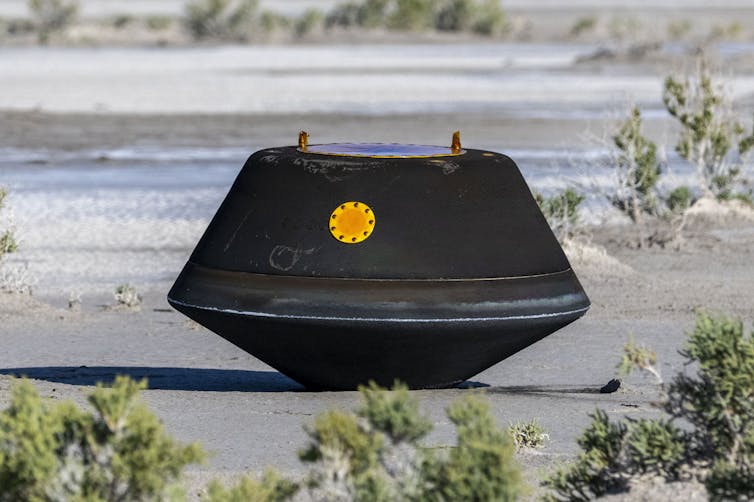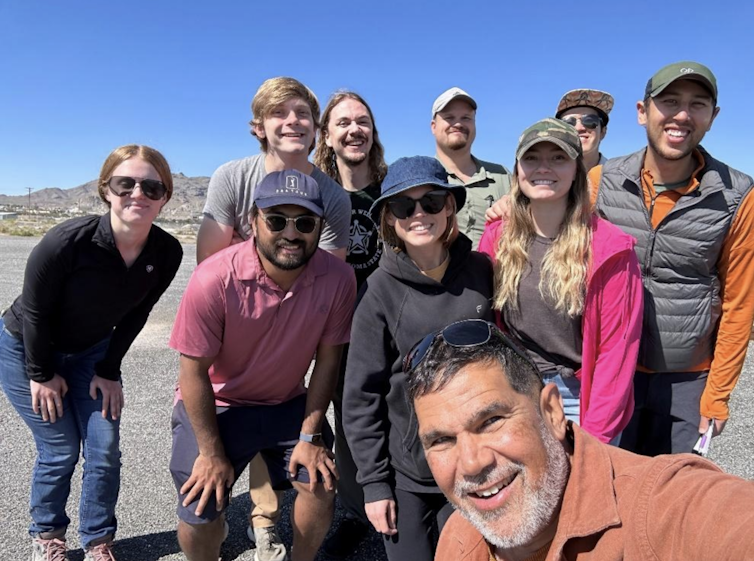Earth is constantly bombarded by fragments of rock and ice, also known as meteoroids, from outer space. Most of the meteoroids are as tiny as grains of sand and small pebbles, and they completely burn up high in the atmosphere. You can see meteoroids larger than about a golf ball when they light up as meteors or shooting stars on a dark, clear night.
While very small meteoroids are common, larger ones – bigger than a dishwasher – are not.
Meteoroids are difficult objects for aerospace and geophysics researchers like us to study, because we can’t usually predict when and where they will hit the atmosphere. But on very rare occasions, we can study artificial objects that enter the atmosphere much like a meteoroid would.
These objects come from space missions designed to transport physical extraterrestrial samples from outer space to Earth. Because of this similarity to meteoroids in entry, we often refer to these sample return capsules, or SRCs, as “artificial meteors.”
Over 80 researchers from more than a dozen institutions recently worked together to study such an “artificial meteor” – NASA’s OSIRIS-REx sample return capsule – as it reentered Earth’s atmosphere.
These institutions included Sandia National Laboratories, NASA’s Jet Propulsion Laboratory, Los Alamos National Laboratory, the Defense Threat Reduction Agency, TDA Research Inc., the University of Hawaii, the Air Force Research Laboratory, the Atomic Weapons Establishment Blacknest, Boise State University, Idaho National Laboratory, Johns Hopkins University, Kochi University of Technology, Nevada National Security Site, Southern Methodist University, the University of Memphis and Oklahoma State University.
This sample return provided our teams with a unique opportunity to measure the sound waves and other phenomena that objects from space produce as they speed through the Earth’s atmosphere.
To capture signals, we installed many sensitive microphones and other instruments in key locations close to the SRC’s flight path.
While space agencies and private companies launch objects into space all the time, the OSIRIS-REx SRC is one of only a handful of objects to return to Earth from interplanetary space since the end of the Apollo missions. Only these objects can achieve the speed of natural meteoroids, making their reentry valuable for studying the properties of natural objects.
Sampling an asteroid
NASA launched the Origins, Spectral Interpretation, Resource Identification, Security, Regolith Explorer, or OSIRIS-REx, mission on Sept. 8, 2016. It traveled to Bennu, a near-Earth asteroid, and collected a sample from its surface in October of 2020.
The sample returned to Earth in the early morning of Sept. 24, 2023, in a sample return capsule. The SRC reentered Earth’s atmosphere over the Pacific Ocean at a speed of over 27,000 mph (43,500 kph) and landed in Utah only a few minutes later.

SRCs produce a shock wave as they plunge deep into the atmosphere, akin to the sonic boom generated by a supersonic jet breaking the sound barrier. The shock wave then loses strength until all that remains is low frequency sound, called infrasound.
While humans can’t hear infrasound, sensitive scientific instruments can detect it, even at great distances. Some of these instruments sit on the ground, while others are suspended in the air from balloons.
Observing the SRC
Our teams of scientists jumped on the SRC reentry as an opportunity to learn more about meteors. One of the teams, led by Siddharth Krishnamoorthy at NASA’s Jet Propulsion Laboratory, used the SRC reentry to test infrasound-detecting balloons that could later be used on the planet Venus.
Another team, led by one of us – Elizabeth Silber – and Danny Bowman at Sandia National Labs used the SRC to better understand how we can use sound to [gather information about meteoroids].
Researchers from many institutions across the country participated in these observational campaigns.
Our teams strategically positioned instruments in locations across a 300-mile (482 km) distance spanning from Eureka, Nevada, to close to the landing site in Utah. The instruments ranged from high-tech custom sensors to smartphones on the ground around the SRC’s flight path and landing site. They monitored the low frequency sound waves from the SRC’s reentry.
In addition to the ground-based sensors, our researchers attached instruments to balloons that floated at twice the altitude of commercial planes during the SRC reentry. The sensors attached to these balloons recorded the sound waves produced by the SRC’s shock wave. These sound waves carried information about the SRC, its movement and the environment it passed through.

The balloon teams had to time the balloons carefully to make sure they would be at the right position when the SRC passed. Team members from NASA’s Jet Propulsion Laboratory, Oklahoma State University and Sandia National Laboratories launched a few different kinds of balloons before dawn from Eureka, Nevada.
Researchers from OSU, Sandia and the University of Hawaii also deployed ground infrasound sensors closer to the SRC’s landing location, along the Utah-Nevada border and at Wendover Airport. While the SRC was already slowing down and Wendover Airport was about three times farther from the flight path than the Eureka deployment, we detected a clear infrasound signal at this site as well.
Researchers on these teams are now analyzing the data to identify the points along the trajectory where instruments recorded the SRC reentry signals. Because the SRC’s flight path spanned approximately 300 miles (482 km), the researchers need to figure out the origin points of the signals as the different sensors detected them.
This was the most-instrumented hypersonic reentry in history.
This research will help our teams figure out what patterns the low-frequency sound waves propagated through the atmosphere and where the shock wave was at its peak intensity.

While our teams are still analyzing the data, the preliminary results show our instruments captured lots of signals that will help future research use low-frequency sound waves to study meteors.
And gaining insights into intricacies about how low-frequency sound waves travel through the atmosphere can help researchers use infrasound to detect hazards on Earth, such as tornadoes and avalanches.

